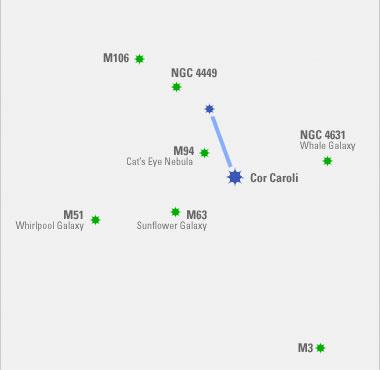

This part of the sky floats above the celestial north pole so there isn't a lot of interstellar dirt obscuring our lines of sight toward some interesting, though faint, galaxies.
M51, the Whirlpool Galaxy, is a good example of quantity equaling quality: time spent with M51 reaps rewards, with brief flashes of clarity that slowly build in your mind?s eye to a fascinating whole. Although faint, two cores are visible; the second, less bright core is that of NGC 5195, a smaller galaxy interacting gravitationally with its large neighbor. Get yourself as dark adapted as possible. Averted vision will bring out hints of the spiral arms. Some nights are better than others.
M63 and M94 are two more spiral galaxies, less spectacular, but interesting to compare with each other and with M101 and M51.
Cor Caroli is a nice double even in small scopes. Note the color difference. Cor Caroli has only 2.3 times the radius of our sun yet shines a hundred times as bright.
NGC 4631 is also known, quite properly, as the Whale Galaxy. It's faint, huge, elongated and completely awesome in the eyepiece.
NGC 4449 is an irregular galaxy in Canes Venatici. In comparison to the Whale, this galaxy is elongated, kinked, and a bit weird looking.
Moving away from some of the fainter targets, M106 is a big galaxy with a bright disc. Easy hunting.
Finally, with an estimated half-million stars, M3 is one of the sky's finest globular clusters. While visible to the naked eye, the more photons your telescope or binoculars can capture, the more stars you'll be able to resolve.
May 2006













